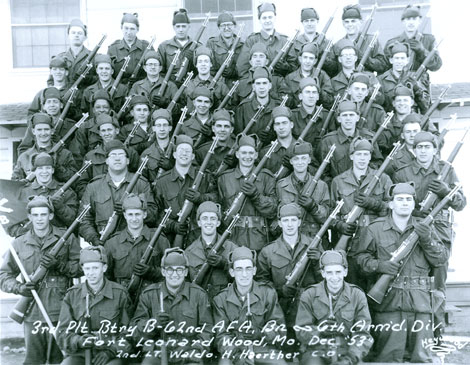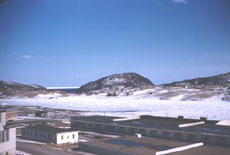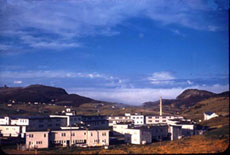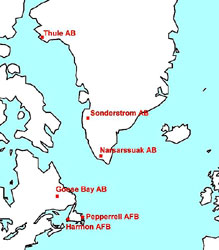|
Appropriate text for military service for Claus
Bryce Peper should follow...
In August of 1940, President Roosevelt and British Ambassador
Lord Lothian began negotiations to lease territories in Newfoundland
and the Caribbean on which to build military bases for defense
against German aggression. This resulted in the creation of
the Canada-United States Permanent Joint Board on Defense on
September 2, 1940, allowing 99-year leases in exchange for 50-over
age destroyers. Detailed lease agreements were not signed until
March, 1941, even though site selection had begun in March,
1940 and field work started in October, 1940 for the first base
near St. Johns, Newfoundland. U.S. troops began arriving on
January 15, 1941.
In April, 1941, Secretary of State Cordell Hull and Danish Ambassador
Henrik Kauffmann signed the Defense of Greenland Agreement,
approved by President Roosevelt on June 7, 1941, in which the
United States agreed to take over the security of Greenland.
Airfields or weather stations were built at Narsarssuak Airfield
(Bluie West One) (BW-1), Angmagssalik (Bluie West Two) (BW-2),
Gronnedal Airfield (Bluie West Nine) (BW-9), Sondrestomfjord
(Bluie West Eight) (BW-8), and Thule (Bluie West Six) (BW-6).
On August 7, 1941, the heavy cruiser Augusta carrying President
Roosevelt arrived at Little Placentia Bay near Argentia, Newfoundland
to meet with Sir Winston Churchill who had sailed on the HMS
Prince of Wales. The purpose was to discuss strategies and logistics
if the United States entered the war. Talks started on August
9 and were completed on August 12. The British Press referred
to this as the Atlantic Charter though neither party had officially
signed it.
The mission of Ft. Pepperrell, the base at St. Johns was to
conduct anti-sub patrols, convoy over-flights of shipping lanes,
and patrol for U-boats. The naval station and naval air base
at Argentia provided anti-sub patrols and task force escorts.
The largest American task force in the Atlantic was based there.
Nearby Ft. McAndrew's main function was to defend the naval
and air base with infantry, seacoast artillery, anti-motor torpedo
boat and anti-aircraft artillery. The base at Stephenville in
western Newfoundland had similar missions and the large airfield
was a stopping and refueling point for USAF aircraft crossing
the Atlantic. The bases in Greenland were also stopping points
and the weather stations gave the allies a strategic advantage
over the Germans in battle planning and was a decisive factor
in D-Day.
With the end of WWII, the importance of the North Atlantic bases
diminished considerably, but with the advent of the Korean War
and the ensuing cold war era, these bases regained their value
for national defense.
These bases had been in two different commands, but in October,
1950, they were organized into a major command designated as
Northeast Air Command (NEAC). Its mission was to provide RADAR
cover over the northwest Atlantic, fighter interceptor, and
to support U.S. Army anti-aircraft defense forces. NEAC's area
was Newfoundland, Labrador, Northeastern Canada, and Greenland.
The Radar stations were known as the Pinetree Line and later
the Dewline. It should be noted that Thule, Greenland is the
midpoint on the great circle between Moscow and New York City.
The name NEAC was discontinued in April, 1957, and the bases
were divided into other organizations. Base closures started
in 1960, and today Thule is the only operational U.S. air base
in the area.
|








